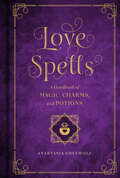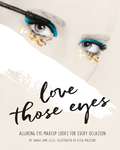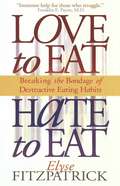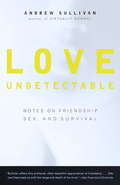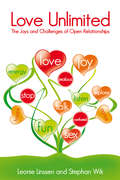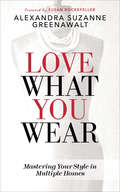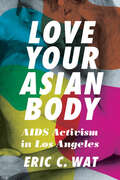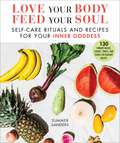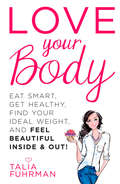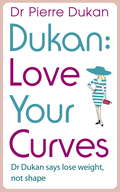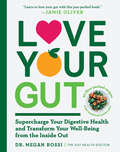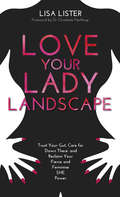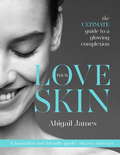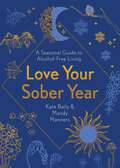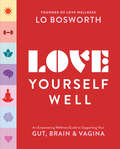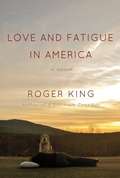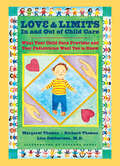- Table View
- List View
Love Spells: A Handbook of Magic, Charms, and Potions
by Anastasia GreywolfLearn how to find, harness, and control love—platonic, romantic, and even animal friendships—in this gorgeous grimoire from the author of Witchcraft.Using the strength of magic, win the heart of the one you love, find out who you’ll marry, and even get your pets to love each other with this comprehensive compendium of the best charms, spells, and potions about love and friendship.This beautiful tome of love spells is drawn from a variety of traditions and spiritualities and will help you successfully navigate your love life by teaching you how to:Find “the one”Get someone to dream about youMake someone tell the truthConceive a childMake a lover come backDecide if you should break upThis book is not just for those looking to improve their romantic life. Love Spells also covers topics left out of many other love magic books, including spells, charms, and potions for maintaining the well-being of platonic friendships and animal friends. Love Spells gives you the tools to:Reconnect with a long-lost friendHeal a rift between best friendsGet along with a roommateGet your pet to like your significant otherCharm a snakeCommunicate with animals with your mindYou do not have to be a believer in the supernatural to get something out of Love Spells. This book is a must-have for all those who want to improve their relationships, whether it be with friends, pets, or lovers. It will empower you to improve any area of your life. Suspend your disbelief and bring on the magic with Love Spells.
Love Stays Strong
by Paula SchneiderA book about the strength of a family's love, especially during times of illness, by cancer survivor and president and CEO of the Susan G. Komen Breast Cancer Foundation, Paula Schneider.Did you know that our universe is constantly expanding? When we look up at the stars, they&’re mixing and moving, flaring and fading. Just like you grow each and every day, change is all around us. I am changing, too.In a beautiful text that all families facing serious illness can relate to, a mother explains her own illness and changing body to her child. Offering comfort, guidance, and explanation, the mother reassures her daughter that no matter how life unfolds in the journey ahead, their love for one another will always stay strong.Lyrically written by Paula Schneider, a breast cancer survivor herself and CEO of the Susan G. Komen Breast Cancer Foundation, and gorgeously illustrated by Nicole Wong, whose family was also touched by cancer, this powerful story shows families that they are not alone.The author's net proceeds from the sales of this book will be donated to the Susan G. Komen Breast Cancer Foundation.
Love That Hair: Head turning styles for every occasion (Love Those/That …)
by Hayley MallinderThe thirty-two styles in this beautiful book give you the repertoire you need to make every day a good hair day; whether you desire tumbling tresses, cute braids, seductive swirls or fierce fishtails. Bringing you looks that can be done in minutes to looks that impress with every tress, Hayley Mallinder helps you to become your very own super stylist, giving you the confidence to create looks that surprise and delight every time. Paired with Hayley is top fashion illustrator Emma Leonard, who has created all the looks and steps in her seductive illustrations, making this an attractive and desirable book. Have fun, feel good, and turn those heads!
Love Those Eyes (Love Those/That …)
by Sarah Jane EllisFifty alluring eye-makeup recipes in a beautifully illustrated book, ideal for giving.In Love Those Eyes, Sarah Ellis and Elisa Mazzone bring you an array of gorgeous eye-makeup tutorials. These mouth-watering ideas will delight all the more when you apply them to your own eyes. As with any great recipe collection, you are inspired to adjust and re-balance the elements to suit your own eye shape, complexion or mood. Featuring light looks to warm your day, cool powerful looks to say you mean business, carefree looks for out and about, dramatic looks for turning those heads. And when you need to party? Look no further - you will rock it! Complete all looks with your favourite mascara or lashes for the perfect finish. They say beauty is in the eye of the beholder. It will be.
Love To Eat, Hate To Eat
by Elyse FitzpatrickNot just another diet book, Elyse Fitzpatrick helps women make realistic, practical steps toward proper eating, health, and emotional balance. With biblical guidelines for victory, this book is ideal for Christian women who want to fully yield this area of their lives to the Lord.
Love Undetectable: Notes on Friendship, Sex, and Surviva
by Andrew Sullivan"I intend to be among the first generation that survives this disease." That was former New Republic editor Andrew Sullivan's first public statement about his HIV diagnosis. Speaking to heterosexual and homosexual audiences alike, this book is about the first steps in that journey of survival.<P> If Sullivan's acclaimed first book, Virtually Normal, was about politics, this long-awaited sequel is about life. In a memoir in the form of three essays, Sullivan asks hard questions about his own life and others'. Can the practice of friendship ever compensate for a life without love? Is sex at war or at peace with spirituality? Can faith endure the randomness of death? Is homosexuality genetic or environmental?Love Undetectable, then, refers to many things: to a virus that, for many, has become "undetectable" in the bloodstream thanks to new drugs, and to the failed search for love and intimacy that helped spread it; to the love of God, which in times of plague seems particularly hard to find and understand; to a sexual orientation long pathologized and denied any status as an equal form of human love; and to the love between friends, a love ignored when it isn't demeaned, and obscured by the more useful imperatives of family and society.In a work destined to be as controversial as his first book, Sullivan takes on religious authorities and gay activists; talks candidly about his own promiscuity and search for love; revisits Freud in the origins of homosexuality; and makes one of the more memorable modern cases for elevating the virtue of friendship over the satisfactions of love. Scholarly, impassioned, wide-ranging, and embattled, Love Undetectable is a book that is ultimately not about homosexuality or plague, but about humanity and mortality.
Love Unlimited
by Stephan Wik Leonie LinssenBased on the case studies of 12 actual couples and individuals who are grappling with the complexities and challenges of "responsible nonmonogamy," this helpful resource delves into various types of open relationships. The stories included have a varied cast of characters-monogamous, heterosexual, homosexual, bisexual, and polyamorous-but they all share a desire to find practical and realistic solutions to their life situations. Each chapter concludes with tools and tips that provide valuable assistance for grasping the subject covered. Accompanied by short texts that give fascinating insights into how other cultures and traditions, from the Taoist to the Celtic and beyond, have accommodated nonmonogamous relationships, this remarkable exploration offers a down-to-earth approach to a growing population.
Love Was Inside
by Andrew JoynerFrom a #1 New York Times bestselling illustrator comes a picture book to celebrate and remember the days we spent inside—the joys and the hardships, the bravery and the resilience, but most of all the love.This book, inspired by kids who found ways to stay connected to the people they love during the pandemic, is about what an imaginative, curious and loving little girl did when her world was turned inside out. The girl played inside, she learned inside, she waited inside. She talked on the phone to her Nan inside. Her days and nights were all inside, and she would think about what she missed outside--the running, cheering, splashing, hugging, and of course her Nan. Finally, when the girl could go outside, she was happy to be there--to hug her Nan, see her friends, and even climb a tree. But she had changed inside, and she knew she would always remember the small things and the big things that made that time special. Here is a picture book that will help young children remember, process, and resolve the feelings they had during the pandemic. Includes prompts to help readers make their own inside story book.
Love What You Wear: Mastering Your Style in Multiple Homes
by Alexandra Suzanne GreenawaltLove What You Wear shows women how to be fabulous at ALL of their homes! High stress career got you on the move? Sick of spending thousands of dollars on clothing you never wear? Tried and failed with personal shoppers at high end department stores? Are you constantly wondering where your favorite sweater is?Love What You Wear will update your style without stress. Get dressed from ANYWHERE in the world. Look and feel great and appropriately dressed to tackle your day. Never stress about what to wear no matter what home you're in. Be your best dressed self wherever you are in the world. Styling powerhouse female clients since 2001, Alexandra's approach is easy and in-depth. Transform your style today!
Love Works Like This: Moving from One Kind of Life to Another
by Lauren SlaterThe author and psychologist gives us a "travelogue" of her pregnancy while struggling to keep mental illness at bay
Love Your Age: The Small-Step Solution to a Better, Longer, Happier Life
by Barbara Hannah GruffermanFilled with healthy habits to help you take charge of your life with wit, energy, and confidence, this inspiring guide will show you how to look, feel, and be your best in a busy, fast-paced world.Warm, engaging, and user-friendly, this powerful, practical guide to aging gracefully will be an indispensable resource for anyone looking to live their best life. Featuring more than a hundred easy-to-adopt "small steps" -- the foundation for ingrained habits that will yield longer, happier, and healthier years - this book will help enrich your life, from health and fitness to style, work and relationships. From checking in with your doctors to changing your fitness routine, cooling hot flashes, tackling social media and updating your wardrobe, transformation really does begin with one step - and Grufferman provides an easy formula for making and breaking the right habits. Packed with expert tips, myth busters, checklists, real-life anecdotes, and sage wisdom, this book offers a new approach to life after 40 that will inspire, rejuvenate, and energize.
Love Your Asian Body: AIDS Activism in Los Angeles
by Eric C. WatThe AIDS crisis reshaped life in Los Angeles in the 1980s and 90s and radicalized a new generation of queer Asian Americans with a broad vision of health equity and sexual freedom. Even amid the fear and grief, Asian American AIDS activists created an infrastructure of care that centered the most stigmatized and provided diverse immigrant communities with the health resources and information they needed. Without a formal blueprint, these young organizers often had to be creative and agitational, and together they reclaimed the pleasure in sex and fostered inclusivity, regardless of HIV status.
Love Your Body Feed Your Soul: Self-Care Rituals and Recipes for Your Inner Goddess
by Summer SandersThe ultimate guide to self-love, health, beauty, and happiness. This is a wellness book that goes way beyond the surface, grounding you in the intrinsic beauty of plant-based foods, while elevating you with inspired skin care recipes and sacred routines that tap into your inner glow and intuition. Filled with vibrant photos that turn you on to the sensuality and real pleasure of sacred beauty, healthful cuisine, and conscious rituals, Summer Sanders, author of Raw and Radiant, dives deep beyond the food and into the heart to awaken the senses and shine light on a new way of connecting to food, health, and life. From topics like beauty, hormones, and cleansing, to motherhood and meditation, this book covers everything you need for total transformation from the inside out: Recipes for natural masks, scrubs, and hair treatmentsTips for seasonal cleansing and natural remediesHealing tonics and smoothiesSelf-care checklists and simple rituals to stay groundedMantras and meditations to connect to the power withinLight and bright food that will make you feel radiantIntuitive eating, cycle syncing, and fully enjoying life and bodyAnd more This book contains everything you need to access and release your inner goddess—it will inspire the radiance of women while supporting us to release the old patriarchal views of beauty and embrace the real feminine powers that are living within us all.
Love Your Body: Eat Smart, Get Healthy, Find Your Ideal Weight, and Feel Beautiful Inside & Out!
by Talia FuhrmanAs the oldest daughter of Joel Fuhrman, MD, bestselling author of Eat to Live and Super Immunity, Talia Fuhrman knows that the true meaning of health and wellness comes not only from delicious, nutrientrich foods, but also from the power of positive energy and zest for a truly fulfilling life. In Love Your Body, Talia Fuhrman shows readers how to get their green juice on, find their ideal weight, and get radiant, clear skin—and also how to gain confidence, enjoy strong friendships, and explore the passions that make them jump out of bed each morning with their widest smiles. Motivated by her own struggles, and those of her friends—weight gain, skin troubles, stomach aches, frequent sickness, migraines—Talia knows that eating a plant-based diet packed with all-natural, nutrient-rich ingredients makes body issues a thing of the past. With a fresh, engaging voice, Talia inspires readers to nourish their mental and emotional health, too. She places a strong emphasis on inner beauty, and offers advice on how to maximize their social lives, and care about the world around them.With nutrition tips, actionable advice, and delicious recipes, this mind-body manual offers a fun, simple roadmap to a vegan lifestyle, and proves that loving your body—inside and out—can be positively delicious!
Love Your Curves: Dr Dukan Says Lose Weight, Not Shape
by Dr Pierre DukanIn Love Your Curves Dr Pierre Dukan looks at why men and women are different shapes. Many women are in a perpetual quest for thinness, convinced that is the key to happiness and the best way to attract a partner. However, Dr Dukan provides scientific evidence to demonstrate that, although society and the media often makes us feel otherwise, curves are natural and much more appealing. Told with humour, Love Your Curves is Dr Dukan's personal message that we should lose weight, not shape. Dr Pierre Dukan is a French medical doctor who has spent his career helping people to lose weight permanently. The Dukan Diet is the culmination of thirty-five years' clinical experience. Beyond its immense success in France, The Dukan Diet has been adopted by 20 countries and translated into 10 languages. Many international observers agree that this is the method most likely to put a stop to the world's weight problems.
Love Your Gut: Supercharge Your Digestive Health And Transform Your Well-being From The Inside Out
by Megan RossiSupport your immunity and fuel your metabolism with this revolutionary guide to gut health, including 50 fiber-packed recipes to nourish your microbiome—from the award-winning Gut Health Doctor (@TheGutHealthDoctor) and author of the forthcoming How to Eat More Plants Publisher’s Note: Love Your Gut was previously published in the UK under the title Eat Yourself Healthy. The path to health and happiness is inside you—literally. It’s your gut! When you eat well, you feed the helpful gut microbes that nourish your metabolism, your immunity, and even your mood. But your microbiome is as unique as you are, so how to eat well varies from person to person. There’s more to it than one-size-fits-all advice like “Take probiotics” and “Eat more fermented foods”—in Love Your Gut, Dr. Megan Rossi cuts through the noise. You’ll learn what your gut actually needs, how it works, and, most importantly, what to do when it’s not loving you back. Gauge your gut health with 11 interactive questionnaires: How happy is your microbiome? Could you have a hidden food intolerance? Are your fruit and veggie choices stuck in a rut? You’ll answer these questions and many more! Craft a personal action plan and treat common problems: Learn to manage IBS, bloating, constipation, heartburn, SIBO, and stress—with evidence-based diet strategies, gut-directed yoga flows, sleep hygiene protocols, bowel massage techniques, and more. Enjoy 50 plant-forward, fiber-filled recipes, including Banana, Fig, and Zucchini Breakfast Loaf, Sautéed Brussels Sprouts and Broccolini with Pesto and Wild Rice, Prebiotic Chocolate Bark, and more! Get ready to discover your happiest, healthiest self. Love your gut!
Love Your Lady Landscape: Trust Your Gut, Care for 'Down There' and Reclaim Your Fierce and Feminine SHE-Power
by Lisa ListerLove Your Lady Landscape is a healing journey through the terrain of what it is to be a woman. When a woman isn't in alignment with her feminine essence, she may experience exhaustion and overwhelm, lack sexual desire or passion for life, and generally feel "out of sync". In this book, Lisa Lister uses a myriad of tools and practices such as Earth based spirituality, shamanic teachings, movement and dance, and breath and sound work to teach women how to reconnect to their feminine wisdom in order to start rebalancing all aspects of their lives. Based on Lisa's own 11-year journey of healing and reconnecting with her body, this book will help you: - release guilt and shame from the past - explore self-pleasure and sensuality - understand, read, and connect with your body's signs and signals - learn about your menstrual cycle and its connection with the rhythms of nature and the universe - discover the sacred art of receiving - express your creativity - find your voice to communicate your needs, wants, and desiresLove Your Lady Landscape will move women into a fiercely loving and healing relationship with their body and will teach them how to use its cycles and signs to create a life of vitality, fulfillment, and creation.
Love Your Sister
by Samuel Johnson Connie JohnsonBrothers and sisters often dare each other to do things - it's what siblings do. However, when Connie Johnson dared her brother Samuel to embark on a one-wheeled odyssey around Australia, she knew it was a big ask. But Connie knew exactly what she was doing and was sure he wouldn't say no. Not this time. <p><p>Born a year apart, Connie and Samuel Johnson have always been close. Sam was by Connie's side when she found out she had cancer at age twelve and again when she was diagnosed at age twenty-two. Then, at thirty-three, Connie was diagnosed with breast cancer; but this time she was told she would not recover. <p><p>As a young mum faced with her own death, Connie wanted to find some meaning in the chaos. And so she dared Sam to help her. Officially there were three aims: promote breast awareness, raise over one million dollars for research - and break the world record for the longest distance travelled on a unicycle. <p><p>However, Connie had a secret fourth aim: to fix Sam. She had no idea if any of it would work out. Neither did he. <p><p>Part memoir, part travel diary, part conversation, Love Your Sister is Connie and Sam's inspiring, moving and unforgettable journey, told in their own distinctive voices. It's a story of love, family, cancer - and the generosity of ordinary Australians.
Love Your Skin
by Abigail James'a beautiful and friendly guide' Melissa Hemsley'Abigail worked wonders on my skin and this book reveals her top tips. If you want to look as good as she does, grab it!' Madeleine ShawRenowned throughout the beauty industry for her 'healing hands', Abigail draws on a decade of practical expertise to provide real solutions to skincare issues. The skin you look at in the mirror is not the same as that of a friend's. Just because they swear by an amazing face cream doesn't mean it's going to be your skincare hero too. Your genetic background, where you live, and what you eat will all have an impact, as will your stress and hydration levels, gut health and sleep patterns. Covering everything from the key product ingredients to look out for, to alternative low-cost solutions and home-made beauty products that really work, Abigail's advice will truly benefit your complexion. From her top habits for healthy skin to the best professional treatments and methods, by way of facial yoga and massage, Love Your Skin is all you need to ensure your skin is always at its best.
Love Your Skin: The Ultimate Guide To A Glowing Complexion
by Abigail JamesRenown throughout the beauty industry for her `healing hands', Abigail draws on a decade of practical expertise to provide real solutions to skincare issues. The skin you look at in the mirror is not the same as that of a friend's. Just because they swear by an amazing face cream doesn't mean it's going to be your skincare hero too. Your genetic background, where you live, and what you eat will all have an impact, as will your stress and hydration levels, gut health and sleep patterns. Covering everything from the key product ingredients to look out for, to alternative low-cost solutions and home-made beauty products that really work, Abigail's advice will truly benefit your complexion. From her top habits for healthy skin to the best professional treatments and methods, by way of facial yoga and massage, Love Your Skin is all you need to ensure your skin is always at its best.
Love Your Sober Year: A Seasonal Guide to Alcohol-Free Living
by Kate BailyHow to develop healing routines for alcohol-free growth using the seasons as your guide. The book explores old wisdoms, new science and the female experience and includes tasks to shift mindset, questions for reflection, nervous system regulations techniques, menstrual and hormonal health tips.
Love Your Sober Year: A Seasonal Guide to Alcohol-Free Living
by Kate BailyHow to develop healing routines for alcohol-free growth using the seasons as your guide. The book explores old wisdoms, new science and the female experience and includes tasks to shift mindset, questions for reflection, nervous system regulations techniques, menstrual and hormonal health tips.
Love Yourself Well: An Empowering Wellness Guide to Supporting Your Gut, Brain, and Vagina
by Lo BosworthA frank and accessible guide to optimizing women’s health by Lo Bosworth—the CEO and founder of Love Wellness—tracing the interconnectivity of the gut, brain, and vagina, and providing natural solutions to intimate problems.Lo Bosworth didn’t know what to do, when—out of nowhere—she began experiencing strange physical ailments like fatigue, yeast infections, and debilitating brain fog. The CEO and former reality TV star was no stranger to anxiety or depression, but those were easier to trace, and more easily solved; these new, mysterious ailments were chronic. Love Yourself Well is inspired by Lo’s personal journey to health, and the setbacks she encountered along the way. As she would come to find, the issues she was experiencing were common—but sadly invisible in conversations about public health. In detailing her own personal journey to better health and empowerment, Lo passes along the lessons she learned in the pursuit of body harmony. Alongside a panel of medical experts, Lo demystifies the science behind the gut-brain-vagina axis, showing how—with frankness and humor—she has become the go-to expert for millennials on sexual health and overall wellness. Most importantly, Lo provides a space to engage honestly and openly about the intimate issues women face—and need to speak about.The book answers questions like:How does my overall health affect my vaginal health?Is there a way to heal leaky gut and leaky brain?Are there supplements and a diet to encourage body harmony?Is my body normal? What is normal when it comes to sexual wellness?Chock full of recipes, exercises, and implementable strategies to meet your wellness goals, Love Yourself Well offers a comprehensive plan to rejuvenate your health, and help you go from feeling blah to feeling balanced.
Love and Fatigue in America
by Roger KingLove and Fatigue in Americarecords an Englishman’s decade-long journey through his newly adopted country in the company of a mystifying illness and a charismatic dog. When he receives an unexpected invitation from an unfamiliar American university, he embraces it as a triumphant new beginning. Instead, on arrival, he is stricken with a persistent inability to stand up or think straight, and things quickly go wrong. Diagnosed with ME disease—chronic fatigue syndrome—he moves restlessly from state to state, woman to woman, and eccentric doctor to eccentric doctor, in a search for a love and a life suited to his new condition. The journey is simultaneously brave, absurd, and instructive. Finding himself prostrate on beds and couches from Los Alamos to Albany, he hears the intimate stories offered by those he encounters—their histories, hurts, and hopes—and from these fragments an unsentimental map emerges of the inner life of a nation. Disability has shifted his interest in America from measuring its opportunities to taking the measure of its humanity. Forced to consider for himself the meaning of a healthy life and how best to nurture it, he incidentally delivers a report on the health of a country. By turns insightful, comic, affecting, and profound, Roger King’sLove and Fatigue in Americabriskly compresses an illness, a nation, and an era through masterly blending of literary forms. In a work that defies categorization, and never loses its pace or poise, the debilitated narrator is, ironically, the most lively and fully awake figure in the book. “Remarkable. . . . [S]mart and funny. . . . [A]musing observations about everything American. . . . [T]his is not a traditional novel. . . . [T]his, as it turns out, is a brilliant perspective from which to view and write about life. . . . [G]reat reckonings unfurl in mere paragraphs. ”—Jackson Newspapers. com “As the disease drives the narrator city to city, woman to woman, and doctor to doctor, it brings into relief many of America’s follies and excesses, most notably our health-care system, which King portrayed as antiquated, bureaucratic, and inhumane. After more than fifteen years, America brings the narrator ‘not aspiration realized, nor a largeness of life fitting to its open spaces, but the nascent ability to be satisfied with less. ’”—The New Yorker
Love and Limits In and Out of Child Care: What Your Child Care Provider and Your Pediatrician Want You to Know
by Susanna Natti Richard Thomas Margaret Thomas Lisa DobberteenLove and Limits In and Out of Child Care is a roadmap for parenting happy, healthy children. Coauthored by day care provider Margaret (Peggy) Thomas, her husband, Richard, and Lisa Dobberteen, a pediatrician who entrusted her own children to Peggy's care, this is an enjoyable and educational guide to everything from TV watching to toilet training.Drawing on the authors' expertise in their respective fields, Love and Limits offers a peek into an ideal child care situation along with advice on medical and developmental issues of real concern to parents. Conversations between Peggy Thomas and Dr. Dobberteen highlight the authors' shared view about the value of loving routines—love and limits—in raising children today. Whether their young children are in full- or part-time child care settings or at home, families will find the combination of common-sense parenting advice and medical insight just right for today's complex world.With a healthy balance of time-proven wisdom and up-to-date medical information, the book offers parents proven strategies for deciding which day-care situation is best, along with practical tips for• establishing bedtime routines• getting along with others• negotiating the logistics of child care—sick days, payment, vacations, and more• enticing picky eaters to eat • keeping toddlers occupied during travel• selecting first aid essentials—what to keep on hand• helping children cope with problems and frustrationsCharmingly illustrated by award-winning children's book illustrator Susanna Natti, this invaluable resource will guide and reassure all parents.
